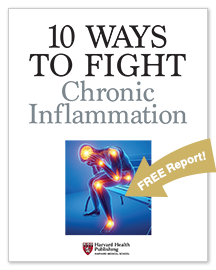
Hemoglobin A1c (HbA1c): What to know if you have diabetes or prediabetes or are at risk for these conditions

What could be causing your blurry vision?

Avocado nutrition: Health benefits and easy recipes

Swimming lessons save lives: What parents should know

Preventing and treating iliotibial (IT) band syndrome: Tips for pain-free movement

Wildfires: How to cope when smoke affects air quality and health

What can magnesium do for you and how much do you need?

Dry socket: Preventing and treating a painful condition that can occur after tooth extraction

What happens during sleep — and how to improve it

How is metastatic prostate cancer detected and treated in men over 70?
Positive psychology
- Reviewed by Mallika Marshall, MD, Contributing Editor
Positive psychology helps to foster happiness and emotional wellness. It does this by helping people capitalize on their strengths, heighten their gratitude and awareness, connect to others, and develop the wisdom needed to live a more meaningful and fulfilling life.
What is positive psychology?
The basis for most of the world's religions begins with a path toward inner peace, deeper meaning, and greater enlightenment — the hallmarks of positive psychology.
The history of positive psychology reveals that though ancient philosophers promoted different pathways to happiness, they believed it begins with knowing your true self, and acting in accordance with your virtues.
A more modern definition of positive psychology disavows the fleeting pleasures of materialism and "winning," to focus on the act of cultivating satisfaction and contentment. It encourages tapping into your inner strengths, and connecting with others to lead to a heightened sense of gratitude and the happiness that comes with it. Pursuing these attributes leads to the benefits of positive psychology: savoring the good in your life by being with the people you love, and finding real pleasure in doing the things you find meaningful.
What are the pillars of positive psychology?
Learning how positive psychology is applied begins with the search for self-fulfillment, which can push back the ill effects of depression, failed relationships, and the drudgery of unfulfilling work.
It's helpful to first understand what won't make you happy. Economist Richard Easterlin first tracked the happiness-income paradox in the 1970s. He demonstrated that money makes people happy, but only up to the point where basic needs are met. One would think youth makes people happy, but people in their 80s rank their psychological well-being even higher than people in their 20s. Having children is supposed to be joyful, but the added stress of caregiving can lead to marital dissatisfaction.
By understanding what does — and does not — make us happy, we can arrive at the three pillars of positive psychology:
- connecting with others
- savoring pleasure
- developing a sense of gratitude.
What is flow and how is it related to positive psychology?
Flow is a state of intense absorption in work or an activity that one finds pleasurable. A skilled woodworker might enter flow by building a chest of drawers, for example. A video gamer can achieve flow by mastering a new challenge on her game console. In either case, the activity leads to a positive short-term emotional experience. Flow theory revolves around creating more of these opportunities, which can be a potent route toward increased happiness.
What happens when you are in a flow state?
- You lose awareness of time.
- You don't care how you look or how you are perceived by others. Your awareness of yourself is only in relation to the activity itself.
- You aren't interrupted by extraneous thoughts.
- You are in control and work effortlessly.
- You have clear goals, but you aren't focused on the goal line.
- You would like to repeat the experience.
What strategies can help you incorporate flow into a positive psychology practice?
- Choose an activity that provides new feelings, experiences, or insights.
- Pay attention to your bodily sensations and posture.
- Overcome the urge to stop every time you make a mistake.
- Accept that being nervous is normal and will ease once you get going.
- Try to work or play with others.
- Maintain your sense of humor.
What is positive thinking?
Positive thinking is the conscious act of finding the positive side of an act or encounter. That driver who cut in front of you? It's a reminder to build distance between you and other motorists. That stressful discussion with your granddaughter about her attire? It's a chance to learn the styles and modes of dress the younger generation is adopting.
There is a difference between positive psychology and positive thinking. Positive psychology is otherwise known as the science of human flourishing, the search for satisfaction and contentment that's within everyone's reach. Positive thoughts and positive attitudes — what we call positive thinking — can lead to direct, positive health outcomes. "When comparing the most optimistic to the least optimistic, the most optimistic have a reduced risk of dying from cancer, infection, stroke, heart disease, and lung disease," says Dr. Eric Kim, who studies the phenomenon at the Harvard T.H. Chan School of Public Health.
Feelings of gratitude, a pillar of positive psychology, are one area where the power of positive thinking and positive psychology intersect. To increase optimism, Dr. Kim advises writing down three things you are grateful for each night, and making a list of the kind things you've done for others.
What is self-compassion?
Psychologists who are interested in topics related to positive psychology, mindfulness, and the science of happiness are beginning to study self-compassion. Self-compassion means "being warm and understanding toward ourselves when we suffer, fail, or feel inadequate," says Kristin Neff, associate professor of human development and culture at the University of Texas, Austin.
There are three components of self-compassion:
Self-kindness is the ability to be warm and understanding toward yourself when you fall short of your goals, to soothe and nurture yourself when confronting pain rather than getting angry.
Common humanity is the awareness that you are not alone in your imperfection. Because everyone makes mistakes, it's easier to forgive yourself for your own failings.
Mindfulness is the nonjudgmental observation of your own thoughts, feelings, and actions. When you look in the mirror, mindfulness helps us accept the bad with the good with a compassionate attitude.
What is mindfulness?
Mindfulness is the practice of focusing your attention on the present moment — hitting the mute button on the anxieties, the distractions, and the "noise" of everyday life — and accepting the here and now without judgment. Mindfulness exercises can lower stress levels and literally rewire the brain. Researchers at Harvard-affiliated Massachusetts General Hospital have reported changes in areas of the brain associated with fear, anger, and related emotions in subjects trained in mindfulness practice. Health care professionals are beginning to bring mindfulness meditation into the mainstream, using this mind-body focus to bring positive change to health attitudes and behaviors.
Many people want to know how to learn mindfulness. It begins by training the mind to focus on the present moment without judgment, often in a systematic way. Mindfulness meditation and a variety of related techniques, including yoga and tai chi, all involve mindfulness. Some of these disciplines rely on a posture, a pose, or the repetition of a phrase (often called a mantra) that allows the stressful parade of thoughts to come and go. Mindfulness can induce what's known as the relaxation response, a calming of your fight-or-flight impulse, which helps reduce the harmful effects of stress.

Hemoglobin A1c (HbA1c): What to know if you have diabetes or prediabetes or are at risk for these conditions

What could be causing your blurry vision?

Avocado nutrition: Health benefits and easy recipes

Swimming lessons save lives: What parents should know

Preventing and treating iliotibial (IT) band syndrome: Tips for pain-free movement

Wildfires: How to cope when smoke affects air quality and health

What can magnesium do for you and how much do you need?

Dry socket: Preventing and treating a painful condition that can occur after tooth extraction

What happens during sleep — and how to improve it

How is metastatic prostate cancer detected and treated in men over 70?
Free Healthbeat Signup
Get the latest in health news delivered to your inbox!
Sign Up


